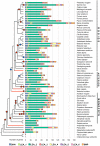Dissecting the Genomic Diversification of Late Embryogenesis Abundant (LEA) Protein Gene Families in Plants
- PMID: 30407531
- PMCID: PMC6379091
- DOI: 10.1093/gbe/evy248
Dissecting the Genomic Diversification of Late Embryogenesis Abundant (LEA) Protein Gene Families in Plants
Abstract
Late embryogenesis abundant (LEA) proteins include eight multigene families that are expressed in response to water loss during seed maturation and in vegetative tissues of desiccation tolerant species. To elucidate LEA proteins evolution and diversification, we performed a comprehensive synteny and phylogenetic analyses of the eight gene families across 60 complete plant genomes. Our integrated comparative genomic approach revealed that synteny conservation and diversification contributed to LEA family expansion and functional diversification in plants. We provide examples that: 1) the genomic diversification of the Dehydrin family contributed to differential evolution of amino acid sequences, protein biochemical properties, and gene expression patterns, and led to the appearance of a novel functional motif in angiosperms; 2) ancient genomic diversification contributed to the evolution of distinct intrinsically disordered regions of LEA_1 proteins; 3) recurrent tandem-duplications contributed to the large expansion of LEA_2; and 4) dynamic synteny diversification played a role on the evolution of LEA_4 and its function on plant desiccation tolerance. Taken together, these results show that multiple evolutionary mechanisms have not only led to genomic diversification but also to structural and functional plasticity among LEA proteins which have jointly contributed to the adaptation of plants to water-limiting environments.
Keywords: LEA proteins; abiotic stress adaptation; desiccation tolerance; gene family evolution; intrinsic disorder.
© The Author(s) 2018. Published by Oxford University Press on behalf of the Society for Molecular Biology and Evolution.
Figures





References
-
- Agarwal T. 2017. Different dehydrins perform separate functions in Physcomitrella patens. Planta 245(1):101–118. - PubMed
-
- Amara I, et al. 2014. Insights into late embryogenesis abundant (LEA) proteins in plants: from structure to the functions. Am J Plant Sci. 05(22):3440–3445.
-
- Babu RC, et al. 2004. HVA1, a LEA gene from barley confers dehydration tolerance in transgenic rice (Oryza sativa L.) via cell membrane protection. Plant Sci. 166:855–862.
-
- Banerjee A, Roychoudhury A.. 2016. Group II late embryogenesis abundant (LEA) proteins: structural and functional aspects in plant abiotic stress. Plant Growth Regul. 79(1):1–17.
Publication types
MeSH terms
Substances
LinkOut - more resources
Full Text Sources

